Santa’s Best Gifts
Finding the right gift is the preoccupying issue of all us Christmas shoppers. We scratch our heads and fret because we’re searching for what to give people who already have most everything.
When your needs are satisfied, you’re a nightmare to shop for.
But if your needs are as basic as a good meal or a warm coat or a dry and secure place to sleep — those take a special kind of Santa.
Caught between needs of too much and needs of too little, we scratched our heads and sought expert advice.
Psychologist Abraham Maslow understood need as the life force that drives all creation. He imagined a hierarchy or five-story mountain we each climb. First we’ve got to eat and drink and breathe. Then we seek shelter and security. Only when we’re warm and full can we strive for more, Maslow said. Drive by drive, we’ll push onward — usually with a great deal of help — toward the lofty achievement of self-actualization.
Food when you’re hungry.
Shelter from the storm.
A community that accepts and loves you.
Recognition … Purposefulness … Self-esteem.
Those are life’s real needs — and they don’t fit under the Christmas tree.
So in this season of giving, we’ve broadened our perspective with five stories of giving, one for each level of Maslow’s mountain.
Along the way we discovered a secret: Giving gifts like these is the way to the top of your own mountain where you’re at your best.
–Sandra Olivetti Martin
Story 1
Where You Go When You Have Nowhere Else to Turn
Project Echo
The basic needs are every American’s birthright, right? Certainly the basic needs of life and breath — food, water, warmth and shelter — are enjoyed by all of us in Chesapeake Country?
Not always.
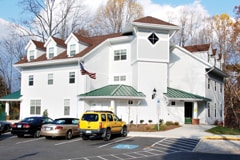 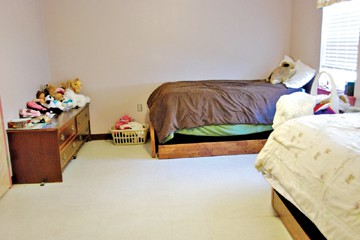 |
Mental illness, injury, economic disaster can and rob individuals and entire families of even those basic needs.
Over the last year, both Calvert and Anne Arundel counties have built new and bigger shelters to cope with the growing population of homeless neighbors. Anne Arundel’s Light House Shelter opened in 1991 with 18 beds, now has room for 45 people. [A Beacon of Hope Shining through Dark Times: http://bayweekly.com/old-site/year09/issue_40/lead_1.html.]
In Calvert County, Project Echo is the place to go when you have nowhere else to turn.
At the Project Echo shelter on Prince Frederick’s Main Street, as many as 40 people find life’s basic needs. Some have problems years in the making. To others, homelessness feels like it happened overnight. They arrive on the doorstep in shock and out of desperation.
“A few weeks before coming to the Echo House, they had a car, home, job and kids. Then someone lost a job or car, and bingo, they’re homeless, and they have nowhere else to turn,” says board member Andrea Jordan.
Project Echo — which stands for Ecumenical Council for the Homeless — was established in 1992 at the response of local churches to Calvert’s need for a shelter in time of emergency. Twenty-six beds were squeezed into a 3,100-square-foot house built in 1948.
Early in the new century, the need outgrew that house. Calvert was in dire need of a bigger shelter.
After 17 months of construction, the gleaming new Echo shelter opened its doors in October, 2009. Four times the size of the original Echo house, the new, three-story building provides beds for individuals and two cottages for families. Echo house is owned by the Calvert County Housing Authority. The $2.3 million cost was funded by the federal, state and county government plus the construction team and the sale of the old house.
The new building arrived just in time. In 2009, 620 people found shelter with Project Echo.
The household is community supported. Empty stomachs are filled with food sent by 22 churches, delivering hot meals 365 days a year, with enough leftover for lunches the next day. Warm beds are made up with the help from Chesapeake Beach Resort and Spa’s donations of gently used sheets and towels. Churches hold blanket and coat drives. Help Association in Chesapeake Beach contributed $10,000 for appliances to outfit the new kitchen. For a decade, Empty Bowl Suppers have raised money — $21,000 last year — to keep stomachs full in Echo House.
Trish Gibson, Project Echo’s new director, professes amazement at daily miracles.
“I told my husband to look for printers, and the next day a lady knocks on the door with a printer. Another time we needed paper plates; some Girl Scouts had been handing lists of necessary items to people entering Walmart. The Scouts came to our door with boxes and boxes of paper products.”
As Gibson wrung her hands on how to fund a backup generator, Dominion Power called with a generator and $10,000 to cover its installation.
Even so, the need is never ending, starting with such personal products as deodorant, toothpaste and toothbrushes, shampoo and soap, band aids, cotton balls and swabs, and liquid hand soap.
Once the basic needs are met, Project Echo helps people begin the climb up the mountain.
Manager Lori Hony greets each with a guiding hand, a big heart and guidance to more resources for help.
“We bring in resources for housing, health, Catholic charities and social services on a regular basis. Residents might qualify for food stamps, Section Eight housing, mental health assessments, counselors for the children or day care vouchers so the parent can go to work,” says director Trish Gipson. “Project Echo is more than a shelter.”
–Sandy Anderson
Story 2
The Gap Between Safety and Desperation Can Be as Thin as the Sole of a Shoe
Orphan Grain Train
To us, those shipping containers piled on freighters heading up and down the Bay may look like stacks of colored Lego blocks. But to residents of Yaoundé, capital city of the African nation of Cameroon, one of them will soon look like a school.
Once emptied, the 40-foot container will remain there, to be converted into a structure where women who have been victims of sexual assault will learn to use the sewing machines and fabric it transported, along with medical and school supplies, so they can be self-supporting members of society instead of being shamed into prostitution.
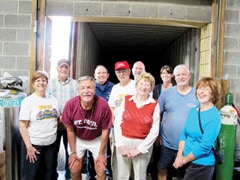 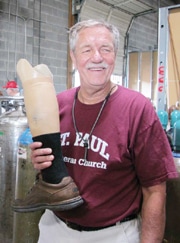 |
The container to Cameroon is the most recent shipment from the Maryland branch of the Orphan Grain Train, a mission of Annapolis’ St. Paul Lutheran Church. The nationwide Nebraska-based charity has never sent any grain nor shipped anything by train, but it has been helping orphans and others in more than 40 countries worldwide since the fall of the Soviet Union in 1992.
For five years, St. Paul parishioners have been sending medical supplies and equipment, clothing, school supplies and furnishings for school and office to destinations from Appalachia and the Katrina-damaged Gulf area to Nicaragua and Kyrgyzstan. This year, they’ll have shipped five of the packed 40-foot containers out of the Port of Baltimore.
“We ship anything to anybody,” says Maryland vice-president Ron Phipps. “The poor need everything.”
In Haiti, to which Grain Train branches across the country sent dozens of containers of relief aid after the 2010 earthquake — including two from St. Paul — shoes are a huge need. Parasitic worms infect those who go barefoot, resulting in amputations that may be done without anesthesia. It’s not even that shoes aren’t available; poverty is such that even the $2.50 cost is too much for many.
It’s not uncommon for such simple, everyday good to make the difference between life and death, according to Elfie Eberle, who founded Orphan Grain Train branches in New York and Maryland.
In the great city of St. Petersburg, Russia, patients were being denied surgery because the hospital didn’t have enough linens. In one of the “miracles” Eberle has had a hand in, her phone call for help to Standard Textile was answered by the international linen supply company’s CEO. He turned out to be a Russian immigrant whose company now partners with Eberle to meet that need.
“There’s plenty of need to go around,” Eberle says. “We pray for the wisdom to focus on the right place.”
Volunteers don’t get paid, proclaims a sign on Orphan Grain Train’s office door at St. Paul’s, Not because they’re worthless, but because they’re priceless.
“I feel great helping. Here we have so much. In life, if you can help one person … well, we get a lot out of it,” says board member John Zindorf, who says he knows “how the other side lives” from being stationed in Taiwan.
“When I really feel good is when the last thing is loaded and we close the trailer door,” says Phipps, a retired college professor. “When the next person opens it, it’ll be like Christmas times 100.”
Besides, he adds of the corps of mostly retired volunteers, averaging 63 in age, who have taken on the job, “you can’t play golf all the time,” he adds.
Scout troops, Naval Academy plebes and the Naval fleet when in port offer periodic assistance in the multi-step process of stacking goods at church … loading them onto a trailer … offloading for storage at Galilee Lutheran Church in Pasadena … reloading and driving to donated warehouse space in Baltimore … and finally packing into a shipping container.
That’s why Orphan Grain Train has a wish of its own: a warehouse where volunteers can load donations directly into containers.
–Lane Page
Story 3
Raising an After-school Family, Complete with Grandmother Butler
Boys & Girls Club of Annapolis & Anne Arundel County
Every day after school, the Boys & Girls Club of Annapolis & Anne Arundel County invites 100 kids through open doors into the open arms of waiting volunteers.
The mission of the 150-year-old international club is to “enable all young people, especially those who need us most, to reach their full potential as productive, caring, responsible citizens.”
At five centers around Anne Arundel County, volunteers and staff work to make that mission statement a reality for every child every day. Most, however, would never call their time with the kids work.
 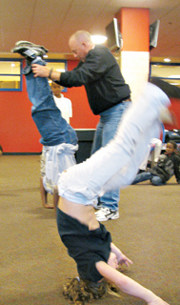 Barbarajean Butler, above, is grandmother of the Boys and Girls Club family at the Wiley H. Bates Center in Annapolis. Don Smith helps kids work on balance and other fitness. |
Barbarajean Butler is grandmother of the Boys and Girls Club family at the three-year-old Wiley H. Bates Center in midtown Annapolis, formerly the county’s first African American high school.
“I help some of the kids with homework, and what I don’t understand well enough to teach them, they help each other with,” Butler says.
“If something happened in school that day we’ll talk about that, too,” says Butler, who says she feels fulfilled at seeing and helping children blossom from the attention of their peers and the volunteers.
“I have seen kids that at first won’t talk and are very bashful who cry to go home,” Butler says. “Now they cry because they don’t want to go home.”
“Being here opens you up,” says Kelsey Johnson, a 14-year-old bloomer.
“Instead of not talking to anyone, you can go out and talk to random people and make friends with them,” says Jaeron Wade, a 15-year-old who, with Johnson, have moved up to the Boys & Girls Club’s teen program.
Don Smith, club controller, is one of the random people who’s become a confidence-building confidant. “One kid came to find me and ran into my office waving his report card he was so proud of straight A’s. Kids just want to show someone who cares,” Smith says.
At all the clubs, every day is dedicated to the kids with one-on-one attention, scheduled activities and a welcoming place to hang out. The Bates club is filled with pool tables, a recording studio, basketball hoops, video games, art supplies, robotics kits, books and a computer lab — as well as volunteers who care and kids who are cared for.
“Kids need structure, too, so we hold them accountable for their actions,” Smith says. “We care about them, so we don’t let them get away with everything, which makes them more responsible.”
Michael Peskin, an eighth grader at Bates Middle School, is growing in responsibility through his time at the club. “My mom works until 4:30,” Peskin says, “So I have to come here. But I always want to since there are activities, and I can play with the kids and help them with homework.”
Peskin wants to continue his own volunteer work after helping last year at the club’s summer camp, so he can give back to the place that continues to give to him.
Club hours are extended with trips and guest speakers through the year and extra activities on weekends. On a November Saturday, the girls’ field hockey team from the Annapolis Area Christian School taught a clinic organized by Matt Kountz, club sports director.
By helping kids make friends and learn sportsmanship and teamwork, Kountz says, the field days “are important even after the game ends.”
As sisters Heaven and Madison Glore took to the field, their mother, Makeeba Glore, said, “They love the attention. The club has given them the opportunity to be exposed to people and things they normally wouldn’t have tried, which greatly benefits them.”
Benefits are shared all around.
“Helping them helps us as well,” said Jamie Gibson, a volunteering field hockey player. “Sometimes you have to watch someone love something before you can love it yourself.”
–Aries Matheos
Story 4
Riding Strong to Independence
Nam Knights Old-Line Chapter
It’s all about the ride.
With thundering memorial rides, the leather-clad Nam Knights wheel around Chesapeake Country to honor the military and the police. As well as ride, they organize bike shows, raffles and a fish fry to meet the needs of veterans, military families and families of members of law enforcement killed or injured on duty.
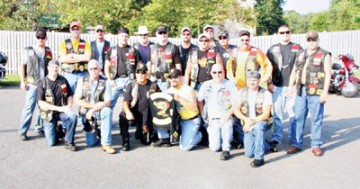 Nam Knights of America at their annual bike show and fundraiser this past summer. |
In Southern Maryland, the Nam Knights Old-Line Chapter is based at the American Legion Hall in Chesapeake Beach, and most of its riders live in Calvert County.
Among the list of non-profits they support are the Wounded Warrior Project, Maryland Concerns for Police Survivors, Operation Second Chance and Malcolm Grove Medical Center Fisher House.
“We’re most involved with Fisher House at Andrews Air Force Base,” said Ray Nieves, Old-Line Chapter president.
Fisher Houses are homes built across the nation on the grounds of military and VA hospitals so families can be near patients as they recuperate. Some 11,000 families a year spend time, for free, at one or another Fisher House.
The first Nam Knights riders were Vietnam veterans. Membership, Nieves says, “is a healing process for those who have been in conflict. There is a brotherhood that develops between the bikers that can’t be replaced by other relationships.”
But the chapter’s first priority is to do good for fellow soldiers and officers. For wounded vets, psychological needs are ongoing as they grapple with great changes that happened suddenly. The help given them is not about pity or coddling but about gaining independence.
It sends the message, says Nieves, that “you are worthy of our interest, our time, our money.”
The bikers contribute to veterans organizations that help them meet challenges, from adjusting to their prosthetic limbs to making homes wheelchair-accessible.
In harnessing their hobby to this cause, Nam Knights contribute more than money. On their bikes, they escort vets from Walter Reed Hospital and Bethesda Naval Hospital to events and outings.
“They make quite a sight, with 15 or 20 bikes around a bus full of vets,” says David Stapen, a marine stationed at Fort Detrick who helps Operation Second Chance.
More than escort, the bikers interact with the wounded men and women.
“At an event, we’ll sit and talk with them and have a meal,” said Nieves. “We get a lot of good feedback from them and hugs. It’s very rewarding.” Even more inspiring is the progress made by the veterans, who don’t want to be pitied.
“You see these young people who have lost an arm or a leg or both legs, with smiles on their faces,” Nieves said. “They are strong and they want to gain independence and get back into the mainstream of life.”
–Louise Vest
Story 5
Booking Achievements for a New Generation
American Association of University Women
Crystal Walker loves books. She relied on them as a child in a home without television and credits them with helping her achieve a life as a writer and translator. Because she believes in their power to help others reach their potential, she has co-chaired the American Association of University Women’s annual book sale for the past three years, working with Cindy Neseth, a former librarian.
This year’s book sale — as usual, held on the first Thursday through Sunday of November — netted over $14,000 in scholarship money for women enrolled at Anne Arundel Community College, as well as roughly 500 children’s books donated to local children’s charities, 250 volumes for local prisons, 300 books sent overseas and 100 books for troops in Afghanistan.
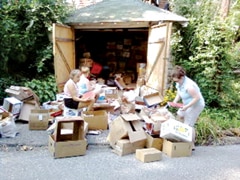  |
The scholarship is, of course, the main course. The rest is gravy, but a rich gravy it is.
With the bad economy, Walker says, “I heard parents telling their children, We only have five dollars to spend, so I feel really good selling children books for 25 cents.”
Sometimes among the donated books she finds historical treasures, which she forwards like paper orphans to the county historical society or the state archives. Last year’s prize was a hand-bound schoolbook signed by long-dead students with names like Tilghman, Calvert and Talbot.
“It was awe inspiring to hold the book used by the sons of Maryland’s founders,” Walker says.
Newcomers to the sale are often surprised by its scope: reference, fiction, biography, humor, books on tape and DVDs, graphic novels, foreign novels and sheet music.
A non-profit dedicated to advancing equity for women and girls through advocacy, education and research, the American Association of University Women is full of accomplished women who have touched thousands of lives. From World War II code breakers to modern professors, they are bent on helping a new generation find their calling.
